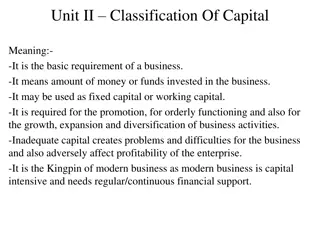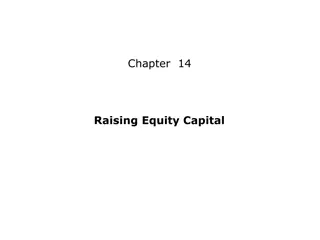Understanding Corporate Finance: Key Considerations for Capital Raising
Corporations make vital decisions about funding environments, profit reinvestment, dividend policies, and debt vs. equity financing. Internal funds like retained earnings play a crucial role in meeting business expenses, reducing the need for external financing. While raising capital through equity or debt issuance is common, companies must carefully consider the implications, costs, and signals associated with each option.
Download Presentation

Please find below an Image/Link to download the presentation.
The content on the website is provided AS IS for your information and personal use only. It may not be sold, licensed, or shared on other websites without obtaining consent from the author. Download presentation by click this link. If you encounter any issues during the download, it is possible that the publisher has removed the file from their server.
E N D
Presentation Transcript
Financial Economics: Corporate Finance Course: BA(H) Economics, Sem 6 For Hansraj College
Typical corporations comprise of the following: 1. Retained profits from business operations- used for reinvestment purposes 2. Sale of new Debt or Equity securities in the financial markets sources of funds/new investments for Given these key options for raising capital, certain important questions need to be answered in depth: Q1. How do firms actually make decisions about the patterns of funding environments? Q2. What are the essential features of debt and equity? How are they different? in different business
1. How much of profit should be reinvested? 2. How much of the profit should be paid out as dividends? (Dividend policy needed) 3. What proportion of deficit should be financed by borrowing vs by issue of equity? (debt policy) A major portion of the money needed for business expenses (like the investment in long-term assets and net working capital), comes from internal sources like the money set aside by a company or retained earnings. In recent years, data has shown that companies often face a financial deficit ( gap between cash requirement of companies and that generated internally). Hence, companies need to either sell new equity or borrow cash from the market.
Funds set aside by firms as depreciation and retained earnings, comprising the internal funds, form a major proportion of the cash that firms need for investment. These sources of internal financing are seemingly more convenient for companies financing options like stock and debt issues. However, there is a worry that managers have an irrational or self-serving aversion to external finance. A manager seeking comfortable employment could be tempted to forego a risky but positive-NPV project compared to external
if it involved launching a new stock issue and answering questions from potential investors. But there are also some good reasons for relying on internally generated funds. (1) The cost of issuing new securities is avoided, for example. (2) Moreover, the announcement of a new equity issue is usually bad news for investors, who worry that the decision signals lower future profits or higher risk. (3) If issues of shares are costly and send a bad-news signal to investors, companies may be justified in looking more carefully at those projects that would require a new stock issue.
Companies mainly raise cash by either issuing equity or debt. Equity: consists of mostly Common stock and in some cases Preferred Stock. Authorized share capital- refers to the maximum number of shares that can be issued by a company. Whenever a company wants to increase the number of authorized shares, it needs shareholders' agreement. Issued and outstanding shares- refers to the issued shares held by investors
Repurchased shares- are those shares that have been bought back by the company from the investors holding them. The issued shares company's books at their Par Value. However, new shares sold to the public mostly exceed par value. The difference between the two is entered in the company's accounts as "additional paid-in capital" or "capital surplus". are entered into the
Company X has an authorized share capital of 600 million shares. In order to raise capital, it has already issued 431 million shares. So, it can issue 600-431 = 169 million shares more without seeking shareholder approval. For issuing shares beyond 169 million, naturally it requires the permission of its shareholders. Say, each share of company X has a Par Value= $0.25 So, the total Book Value of the issued shares = 431*$0.25 = $108 million If X sold an additional 100,000 shares at $40 a share, the common stock account would increase by an amount = 100,000*$0.25 = $25,000 Hence, the Capital Surplus Account would have increased by 100,000*$(40-0.25) = $3,975,000
Common investors as well as financial institutions) are the actual owners of a corporation. For a company that has issued no other securities (e.g debt), the shareholders have complete "cash flow rights" as well as "control rights". If the company takes a bank loan then the bank gets a privileged, but limited, right to cash flows; the residual cash-flow rights are left to the stockholder. The bank may impose restrictions on activities of the company. This limits the control of shareholders while still retaining control over decisions necessary to run the company efficiently. stockholders (comprises of individuals operating and investment
In the case of bankruptcy of the firm, however, the cash-flow and control rights of shareholders are highly restricted and may be eliminated completely. In absence of a rescue/reorganization plan the bank will become the new owner of the firm and thus acquire the cash-flow and control rights of ownership. The common stockholders in widely held corporations still have the residual rights over the cash flows and have the ultimate right of control over the company s affairs. In practice, however, their control is limited to an entitlement to vote, either in person or by proxy, on appointments to the board of directors, and on other crucial matters such as the decision to merge.
Depending company's articles of incorporations, there can be a majority voting system or a cumulative voting system. In majority voting system, each director is voted upon separately and stockholders can cast one vote for each share that they own. In cumulative voting system, the directors are voted upon jointly and stockholders can allot all their votes to just one candidates, if they like. upon the specifications in a
Most of the issues are decided by a simple majority of votes cast. However, some decisions (specified in the company's charter, require a supermajority of vote (e.g to approve a merger). Sometimes, a company may have two classes of stock outstanding, differing only in their right to vote. Say, if a company needs fresh equity capital but its existing shareholders do not wish to give up their control of the firm. In this case, the existing shares could be labeled "class A" and then "class B" shares with limited voting privileges could be issued to outsiders. Shareholders of both classes have same cash-flow rights (identical claims to the company's assets, earnings, and dividends) but different control rights. Say, each A share could have 5 votes while B shares only 1. The class A shares capture the private benefits available to their shareholders compared to class B shares.
Preferred stock issues can be a useful method in financing in special situations like mergers and others. They generally form a smaller part of a company's equity, which is largely dominated by common stock. Preferred stock offers a series of fixed payments to the investors. Most issues of preferred are known as cumulative preferred stock, meaning that the firm must pay all past preferred dividends stockholders get any money. before common
Preferred stockholders generally gain some voting rights, if the preferred dividend, stockholders are obliged to share control of the company with the preferred holders. In addition, failure to pay the preferred dividend tends to damage the reputation of the company with investors, so management is careful about such defaults company that misses common a so the
As discussed, one way in which firms raise capital is by issue of equity in the financial markets. In borrowing money, they periodic interest payments and to repay the principal. However, this liability is limited. The company's stockholders have the right to default on the debt. They may choose to do by surrendering the company's assets to its lenders, in case of the value of assets being lower than the amount of the company's debt. are obliged to make
The company's interest payments are deducted from before-tax income, whereas dividends on common and preferred stock are paid from after-tax income. Hence, a tax subsidy is usually provided on the use of debt as a source of funding. The choices that the company faces are: 1. Should the company borrow short-tem or long- term? 2. Should the debt be fixed or floating rate? 3. Which currency should it borrow?
4. What promises should the it make to the lender? In addition to a collateral, the firm provides assurances to the lender of using the money well without taking unreasonable risks. 5. Should it issue straight or convertible bonds? A "warrant" issued by a company gives the holder the option of buying a set number of the company's shares at a set price before a set date. Similarly, a "convertible bond" gives its owner the option (not obligation) to exchange the bond for a set number of shares.
Companies raise money by selling financial assets like stocks and bonds. This increases the cash amount held by the company and the amount of stocks and bonds held by the public. This issue of securities by corporations in the primary market is known as Primary Issue. On the contrary, the purchases and sales of stocks/bonds among investors in the secondary market are known as Secondary Transactions. Such transactions only lead to a simple transfer of ownership from on person to another, without affecting the company's cash, assets or operations.
In financial markets, the Financial Institutions act as intermediaries that channelize the savings of multiple individuals and reinvest them in the markets. Financial intermediaries manufacturing corporation by virtue of the fact that they may raise money in special ways, such as taking deposits or by selling insurance policies. In addition, financial intermediaries invest in financial assets, like stocks, bonds, or loans to businesses or individuals. differ from a
Key roles of financial intermediaries: 1. The Payment alternatives to cash for investment purposes 2. Borrowing and Lending- Almost all financial institutions help in channelize savings towards those who can use them efficiently. 3. Pooling risk- Financial markets and institutions allow firms and individuals to pool their risks (example, investing in a mutual fund that invests in a diversified portfolio of financial assets) Mechanism- They provide























